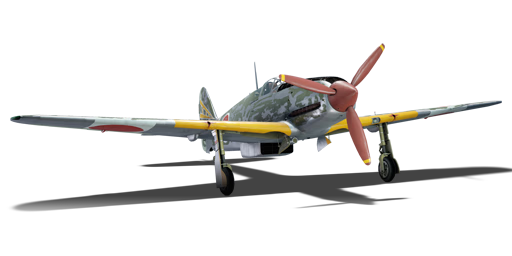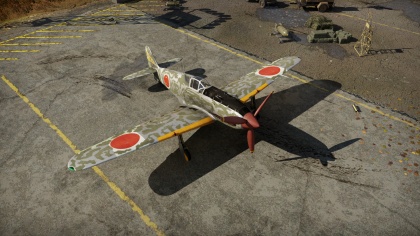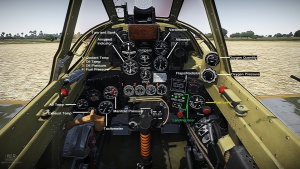Difference between revisions of "Ki-61-I ko"
(→Usage in battles) (Tag: Visual edit) |
(→Usage in battles) (Tag: Visual edit) |
||
| Line 145: | Line 145: | ||
Only elevator trim is available, so when the stick is at its deadzone, the Ki-61 will roll and yaw to the left side. Therefore you always need to pull the stick to the right which can get a bit annoying. Usually, a trim of around -7% is enough. But when carrying the 2x 250kg bombload, no negative trim is needed. | Only elevator trim is available, so when the stick is at its deadzone, the Ki-61 will roll and yaw to the left side. Therefore you always need to pull the stick to the right which can get a bit annoying. Usually, a trim of around -7% is enough. But when carrying the 2x 250kg bombload, no negative trim is needed. | ||
| + | |||
| + | For dogfighting, it is always safer to enter with an altitude advantage. Most dogfights in sim happen below 3,000m so the Ki-61 can easily climb up to that altitude. As mentioned in the description, its climb rate is actually great, don't get misled by the stat card. Once at an advantageous height, boom & zoom the enemies. The Ki-61 can easily accelerate to more than 550 kph in a dive which is decently fast but requires more precise maneuvers to get the correct lead, since the faster you go the smaller the shooting window is. A successful pass will not usually cripple the enemy given you weak firepower, so multiple attacks are needed to destroy one plane. Aside from BnZ, the Ki-61 is also excellent at turn fighting--with the appropriate opponent, of course. Except a few dedicated turn fighters, the Ki-61 can out-turn and get on most opponents' tail with combat flaps deployed. Note: do not turn with Spitfires or Zeros, you will never out-turn them. If you see a plane with a streamlined inline engine and large, elliptical wings (Spitfire) or something with rounded wingtips and stablisers tips, a radial engine and a pointy tail (A6M), try some defensive maneuvers like barrel rolls or disengage by diving towards a nearby friendly airfield. Note that the Ki-61's roll rate is very average so avoid maneuvers like scissors. | ||
=== Manual Engine Control === | === Manual Engine Control === | ||
Revision as of 08:15, 17 July 2020
Contents
| This page is about the Japanese fighter Ki-61-I ko. For other versions, see Ki-61 (Family). |
Description
The Ki-61-I ko Hien is a rank Japanese fighter
with a battle rating of (AB), (RB), and (SB). It has been in the game since the start of the Open Beta Test prior to Update 1.27.
While Japan is famous for turn-fighters like the Zero, the Ki-61 Hien will make "boom and zoom" pilots feel at home. Possessing good high altitude performance, good climb rate and good diving capabilities, this "energy fighter" flies much like the Bf-109 which inspired its design... though the Japanese traded quite a bit of firepower in favour of manoeuvrability. This allows the Hien pilot to choose what role he or she wants to play in the battle. One could play the reserved, high flying energy fighter, or if the situation dictates, the aggressive low flying dogfighter (against certain opponents). Compared to the "Zero" it is faster, has a higher climb rate, and handles better at higher speeds... but is no match in overall manoeuvrability.
Vehicle characteristics
The Ki-61-I ko has a rather weak armament and lacks flexibility, as the Hien is unable to equip bombs or ground targets belts. The Ki-61-I ko utilises two 12.7 mm Ho-103 machine guns and two 7.7 mm Type 89 machine guns. Generally, both are unreliable and it often takes hundreds of rounds to destroy an enemy plane. This is due to the lack of primer in the rounds themselves. 12.7 mm rounds fired by the M2 Browning may seem to do more damage because they have more primer which dictates how fast the round will exit the barrel. Due to this, it is necessary to get up close to enemies. Aim for the engine, pilot, or fuel tanks if the location is known. Remember to lead with these machine guns, as the rounds are not high velocity. The 7.7 mm rounds will hardly damage any plane with armour, so the Hien relies on its 12.7 mm guns which are fairly lacklustre.
The low muzzle velocity of both weapons means that pilots may have to close to short range in order to hit and deal significant damage to targets. Even so, it will require some time to critically damage tougher aircraft such as bombers or attackers. However, with accuracy and shot placement, the large ammunition pool can work to your advantage.
The Hien also comes equipped with an armoured plate at the pilot seat as well as rudimentary self-sealing fuel tanks.
General info
Flight performance
Describe how the aircraft behaves in the air. Speed, manoeuvrability, acceleration and allowable loads - these are the most important characteristics of the vehicle.
| Characteristics | |||||||
|---|---|---|---|---|---|---|---|
| Stock | |||||||
| Max Speed (km/h at 5,000 m) |
Max altitude (meters) |
Turn time (seconds) |
Rate of climb (meters/second) |
Take-off run (meters) | |||
| AB | RB | AB | RB | AB | RB | ||
| 572 | 557 | 20.6 | 21.2 | 8.5 | 8.5 | 420 | |
| Upgraded | |||||||
| Max Speed (km/h at 5,000 m) |
Max altitude (meters) |
Turn time (seconds) |
Rate of climb (meters/second) |
Take-off run (meters) | |||
| AB | RB | AB | RB | AB | RB | ||
| 612 | 590 | 19.5 | 19.8 | 15.5 | 11.6 | 420 | |
Details
| Features | ||||
|---|---|---|---|---|
| Combat flaps | Take-off flaps | Landing flaps | Air brakes | Arrestor gear |
| ✓ | ✓ | ✓ | X | X |
| Limits | ||||
|---|---|---|---|---|
| Wing-break speed (km/h) |
Gear limit (km/h) |
Combat flaps (km/h) |
Max Static G | |
| + | - | |||
| 500 | ~11 | ~8 | ||
| Optimal velocities | |||
|---|---|---|---|
| Ailerons (km/h) |
Rudder (km/h) |
Elevators (km/h) |
Radiator (km/h) |
| < 360 | < 350 | < 460 | > 312 |
| Compressor (RB/SB) | ||
|---|---|---|
| Setting 1 | ||
| Optimal altitude | 100% Engine power | WEP Engine power |
| 4,750 m | 1,100 hp | 1,232 hp |
Survivability and armour
- 13 mm Steel plate behind the pilot
Armaments
Offensive armament
The Ki-61-I ko is armed with:
- 2 x 12.7 mm Ho-103 army machine guns, nose-mounted (400 rpg = 800 total)
- 2 x 7.7 mm Type 89 army machine guns, wing-mounted (400 rpg = 800 total)
Usage in battles
Realistic battles
The Ki-61 is best utilised as a multi-purpose fighter. Although proficient at energy fighting, the Ki-61 is also generally good at standard manoeuvres. It may lose turn fights with some enemy aircraft like the A6M, but nonetheless it can still be used in multiple roles. The Ki-61 is your standard "jack of all trades". It's not incredibly good at anything it does but it is even across the board. This allows the Ki-61 pilot to choose what role he or she wants to play in the battle. One could play the reserved, high flying energy fighter, or the aggressive low flying dog-fighter. The Ki-61 allows these choices.
One of the major advantages the Ki-61-I ko has is its climb rate. The stat card may be misleading, but this plane can reach altitudes beyond that of most of its opponents. This allows the Hien to choose when and where it wants to fight. Once at a high altitude the Hien pilot may choose to dive lower to attack an enemy. If the enemy is not destroyed on the first pass, it is recommended to climb sharply and gain altitude. By doing this, the Hien sets itself up for another attack while not being in the range of the enemy's guns. (Standard Boom and Zoom tactics)
If caught in a sticky situation, the Hien pilot may choose to do several things. Depending on your altitude, executing rolling scissors or an overshoot may be a valid tactic. try to make the enemy pilot feel pressured to disengage. Depending on the enemy's aircraft, use your speed to your advantage and try to get away. The surest tactic would be communicating with teammates to ensure your assailant's death. Once tailed, the Hien pilot can "set up" an enemy by nosing up about 70 degrees so the entirety of the enemy plane is shown. At this stage, ideally, your teammate is arriving to save the day.
Simulator battles
In sim, the Ki-61 can be used in BnZ fighting, turn fighting, intercepting (to some extent) and some ground pounding. The Ki-61 is overall a pretty friendly plane to fly. It is quite fast, handles nicely at all speeds, has decent visibility especially over the nose, climbs great and has lots of ammo. However its disadvantages are the weak protection and poor damage of the 4 MG.
Before taking off, bring at least 30 minutes of fuel for longer patrol time. Set the convergence to around 250m since your MG have low velocity therefore dealing less damage at longer range.
If you are not using MEC, use around 95% throttle when cruising below 3000m since the engine will slowly heat up at full throttle. But full throttle is fine at higher altitudes.
Only elevator trim is available, so when the stick is at its deadzone, the Ki-61 will roll and yaw to the left side. Therefore you always need to pull the stick to the right which can get a bit annoying. Usually, a trim of around -7% is enough. But when carrying the 2x 250kg bombload, no negative trim is needed.
For dogfighting, it is always safer to enter with an altitude advantage. Most dogfights in sim happen below 3,000m so the Ki-61 can easily climb up to that altitude. As mentioned in the description, its climb rate is actually great, don't get misled by the stat card. Once at an advantageous height, boom & zoom the enemies. The Ki-61 can easily accelerate to more than 550 kph in a dive which is decently fast but requires more precise maneuvers to get the correct lead, since the faster you go the smaller the shooting window is. A successful pass will not usually cripple the enemy given you weak firepower, so multiple attacks are needed to destroy one plane. Aside from BnZ, the Ki-61 is also excellent at turn fighting--with the appropriate opponent, of course. Except a few dedicated turn fighters, the Ki-61 can out-turn and get on most opponents' tail with combat flaps deployed. Note: do not turn with Spitfires or Zeros, you will never out-turn them. If you see a plane with a streamlined inline engine and large, elliptical wings (Spitfire) or something with rounded wingtips and stablisers tips, a radial engine and a pointy tail (A6M), try some defensive maneuvers like barrel rolls or disengage by diving towards a nearby friendly airfield. Note that the Ki-61's roll rate is very average so avoid maneuvers like scissors.
Manual Engine Control
| MEC elements | ||||||
|---|---|---|---|---|---|---|
| Mixer | Pitch | Radiator | Supercharger | Turbocharger | ||
| Oil | Water | Type | ||||
| Not controllable | Controllable Not auto controlled |
Controllable Not auto controlled |
Controllable Not auto controlled |
Separate | Not controllable 1 gear |
Not controllable |
Modules
| Tier | Flight performance | Survivability | Weaponry | |
|---|---|---|---|---|
| I | Fuselage repair | Radiator | Offensive 7 mm | |
| II | Compressor | Airframe | New 7 mm MGs | |
| III | Wings repair | Engine | Offensive 12 mm | |
| IV | Engine injection | Cover | New 12 mm MGs | |
- Unlocking the performance modules should be a Hien pilot's first concern, since there are only two weaponry modules. The stock machine gun belts aren't very good in a general sense, but neither are the others. The "New 12.7 mm MGs" can be helpful as it allows for longer periods of firing. Unlocking the 7.7 mm belts can also be beneficial because you can equip belts with more armour piercing rounds.
Pros and cons
Pros:
- Fast compared to contemporary planes
- Above average manoeuvrability
- Good climb rate
- Good diving capabilities
- High ammunition count at 400 rpg
- Self-sealing fuel tanks
- Some armour protection
Cons:
- Relatively weak armaments, especially after heavy machine guns run out of ammunition
- Poor rear visibility
- Average handling characteristics
- No payloads
- Average roll rate that worsens as speed increases
History
The Ki-61 was first put into service in with a special training unit, the 23rd Chutai, and entered combat for first time in early 1943, during the New Guinea campaign. The Hiens were sent into a difficult theatre where jungles and adverse weather conditions coupled with a lack of spare parts quickly made short work of the Japanese fighters. Nonetheless, the Hien proved to be a worthy adversary and it even outclassed the P-40. Towards the end of the war, Ki-61s were relied upon heavily to defend the Japanese mainland from B-29 attacks. Some pilots used ramming attacks to down the Superfortresses. Soon, entire "special attack squadrons" were formed for the sole purpose of downing B-29s via the ramming method.
In-game description
A lightweight multipurpose fighter plane, the Ki-61 Hien ("Swallow") was well-armed and well-armoured.
From the very beginning, the makers of the Ki-61 concerned themselves with protecting the fuel tanks and the pilot. The light multipurpose fighter was an effective answer to "hit-and-run" fighters, thanks to its survivability and high diving speed.
The Ki-61 had a Kawasaki Ha-40 liquid-cooled inverted V12 engine, a licensed copy of the DB 601A, capable of 1175 hp.
A prototype was ready in 1941, and by the next year the first production models were manufactured and the Ki-61 entered service.
To strengthen armament in the Ki-61-I, instead wing-mounted machine guns of the previous models Ki-61-1-Ko and -Otsu was established by German's 20-mm cannons MG 151/20, which in the amount of 800 units in August 1943 were taken to Japan by submarines.
All in all, 3,078 Ki-61 fighters (of various types) were produced.
Media
See also
External links
Paste links to sources and external resources, such as:
- topic on the official game forum;
- encyclopedia page on the aircraft;
- other literature.
| Kawasaki Aircraft Industries (川崎航空機工業株式会社) | |
|---|---|
| Biplane Fighters | Ki-10-I · Ki-10-I C · Ki-10-II · Ki-10-II C |
| Fighters | Ki-61-I ko · Ki-61-I otsu · Ki-61-I hei · Tada's Ki-61-I hei · Ki-61-I tei · Ki-61-II Otsu Kai |
| Ki-100 · Ki-100-II | |
| Interceptors | Ki-45 ko · Ki-45 otsu · Ki-45 hei · Ki-45 tei |
| Ki-96 | |
| Ki-102 otsu | |
| Ki-108 Kai | |
| Bombers | Ki-32 |
| Ki-48-II otsu | |
| Captured | ␗Ki-45 hei/tei · ␗Ki-61-I otsu · ▃Ki-61-Ib |
| See also | Kawasaki Shipyard Co. |
| Japan fighters | |
|---|---|
| Navy | |
| Carrier-based fighter | |
| A5M | A5M4 · Hagiri's A5M4 |
| A6M | A6M2 mod. 11 · A6M2 · A6M3 · A6M3 mod. 22 · A6M3 mod. 22Ko · A6M5 · A6M5 Ko · A6M5 otsu · A6M5 Hei · A6M6c |
| A7He | A7He1* |
| A7M | A7M1 (NK9H) · A7M2 |
| Land-based Fighter | |
| J2M | J2M2 · J2M3 · J2M4 Kai · J2M5 · J2M5 (30 mm) |
| J6K | J6K1 |
| J7W | J7W1 |
| N1K-J | N1K1-Ja · N1K2-J · N1K2-Ja |
| Fighter seaplane | |
| N1K | N1K1 |
| A6M-N | A6M2-N |
| Army | |
| Ki-10 | Ki-10-I · Ki-10-I C · Ki-10-II · Ki-10-II C |
| Ki-27 | Ki-27 otsu · Ki-27 otsu Tachiarai |
| Ki-43 | Ki-43-I · Ki-43-II · Ki-43-III otsu |
| Ki-44 | Ki-44-I · Ki-44-I 34 · Ki-44-II otsu · Ki-44-II hei |
| Ki-61 | Ki-61-I ko · Ki-61-I otsu · Ki-61-I hei · Tada's Ki-61-I hei · Ki-61-I tei · Ki-61-II Otsu Kai |
| Ki-84 | Ki-84 ko · Ki-84 otsu · Ki-84 hei |
| Ki-87 | Ki-87 |
| Ki-94 | Ki-94-II |
| Ki-100 | Ki-100 · Ki-100-II |
| Other countries | ▅F4U-1A · ▅P-51C-11-NT · ▅Bf 109 E-7 · ▅Fw 190 A-5 |
| *Imported designation of the He 112 (A6M was in development - A7M would take A7 designation after the cancelation of the A7He) | |






